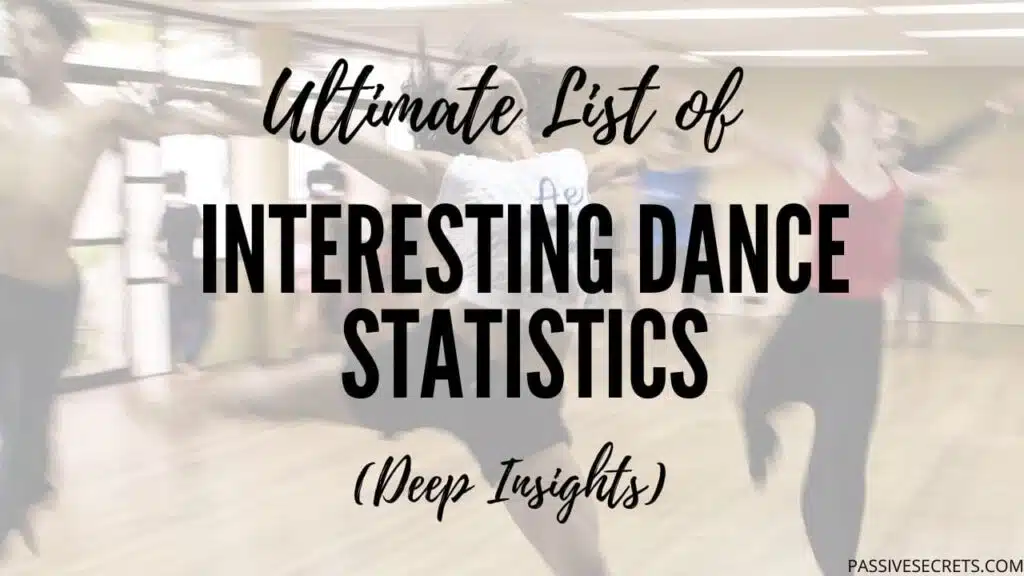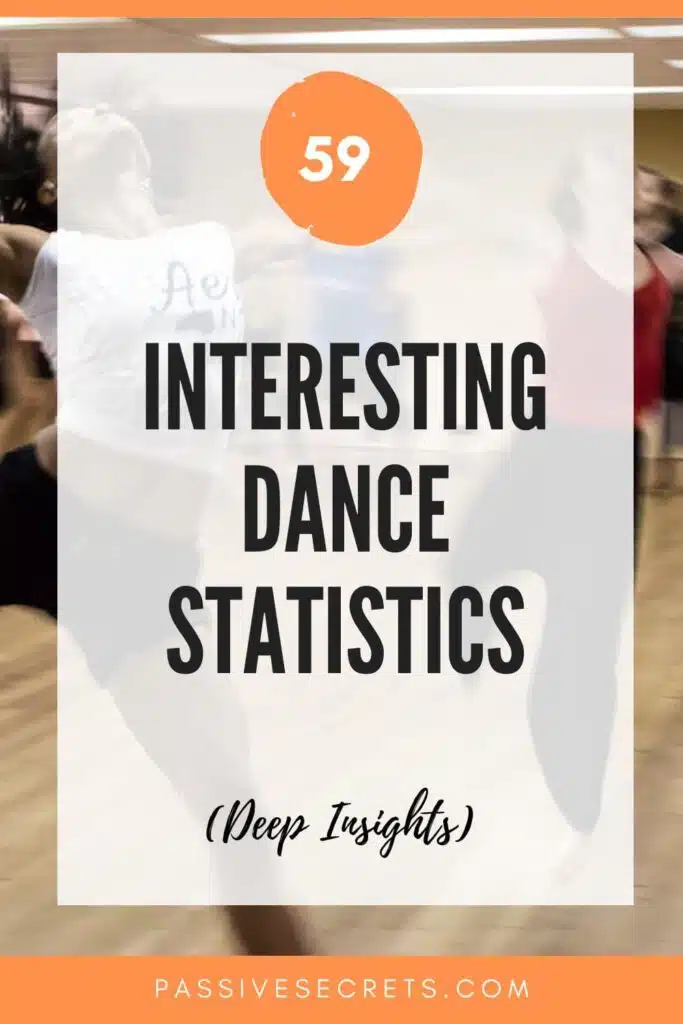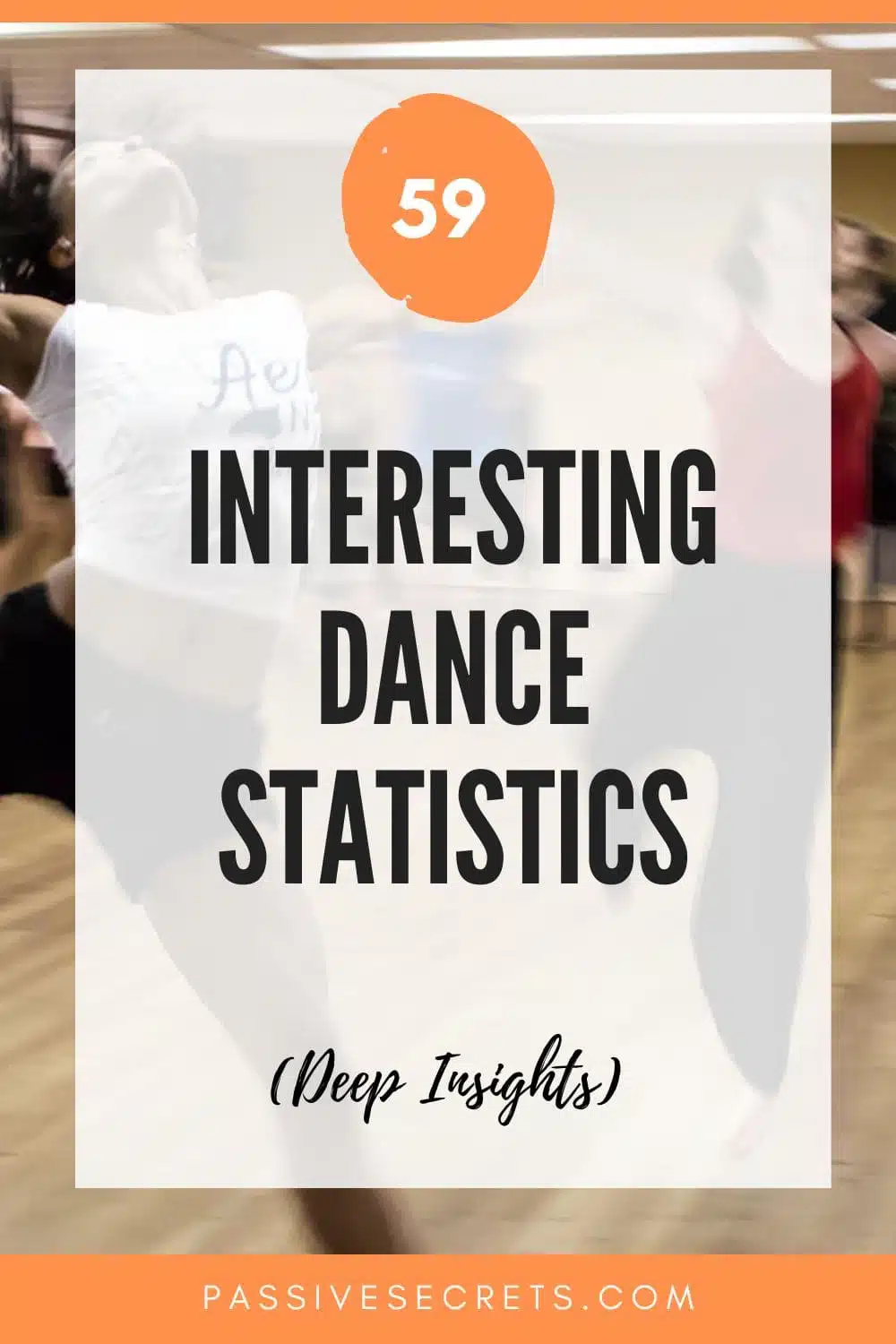
Did you know the earliest evidence of dance was found in a cave in India that is around 9,000 years old?
From ballet to hip hop, from ballroom to contemporary, dance has long been a universal language that has moved across borders, cultures, and generations.
But beyond its captivating performances, the world of dance also offers fascinating insights through its numbers.
In this article, we’ll be exploring some of the most interesting dance statistics, shedding light on the state of dance today and how it shapes our society.
So, put on your dancing shoes as we explore the captivating realm of dance statistics.
Key Dance Statistics (Editor’s Pick)
- There are around 13,900 professional dancers employed in the United States.
- It is estimated that there will be around 3,000 job opportunities for dancers and choreographers each year for the next decade.
- The typical age for male Dancers and choreographers working in the industry is 32.1, while for females, it is 28.1.
- As of the fourth quarter of 2023, it was estimated that around 10,200 dancers and choreographers were employed in the United Kingdom.
- The median hourly wage for choreographers stood at $25.00.
- The typical hourly wage for a Dance Studio Owner in the United States is $22.91.
General Dance Statistics
1. There are around 13,900 professional dancers employed in the United States. (source)
These dancers work for dance, opera, theater, and film/video organizations. They are also contracted for particular concerts and performances, which can last from one night to several years.
2. Musicals are the favorite genre in London theaters, with nearly 9.3 million people attending in 2019, which significantly exceeds the 4.2 million attendance for plays. (source)
Although there was a slight decline in the number of attendees for musicals from the year before, the number of people going to see plays rose.
3. Dancers and choreographers’ employment is expected to expand by 5% between 2022 and 2032, outpacing the overall rate. (source)
4. By 2019, there were 8,000 people employed in these roles outside of the creative sectors. (source)
5. Dancing provides mental health advantages, including enhanced memory, stimulation of the brain’s reward mechanisms, and alleviation of stress and anxiety, among other benefits. (source)
6. The global dancewear market was worth $1.1 billion in 2020 and is expected to reach $1.7 billion by 2030, rising at a CAGR of 4.8% between 2021 and 2030. (source)
Dancewear consists of dance clothes designed for certain dance forms and worn exclusively at dance events and concerts.
7. It is believed that dancing can fight diseases like dementia by 76%, which is significantly more effective than reading, which reduces diseases by 38%. (source)
8. Only around 3 percent of those who pursue dancing end up having professional careers in dance. (source)
9. The earliest evidence of dance was found in a cave in India that is around 9,000 years old. (source)
10. A dancing marathon is precisely as it seems. The record for the longest one stands at 126 hours. Bendana Napal, who was eighteen at the time, set this record in 2018. (source)
11. Between March and June 2020, the arts and entertainment sector experienced a 44.5% decrease in its monthly gross domestic product (GDP) output, measured by gross value added (GVA), compared to the previous three months. (source)
12. In 2023, the dance studio industry generated $4.4 billion in revenue. (source)
13. The market of the Dance Studios Industry increased by 4.5% in 2023. (source)
14. Between 2018 and 2023, the US Dance Studios industry experienced an average annual growth rate of 1.7% in market size. (source)
15. During the pandemic, dance organizations, groups, and project budgets saw an average reduction of nearly 28% due to losses in both earned and contributed revenue. (source)
16. The smallest organizations are the hardest hit, experiencing budget reductions of almost half (an average of 48%). (source)
17. Dance entities have continually adjusted their financial picture and projections as the pandemic has gone on. (source)
For example, while 31% of respondents reported budgets less than $50K pre-pandemic, 43% were in this budget category mid-pandemic.
18. Matt Steffanina is the leading dancer on YouTube, boasting more than 13 million subscribers spread across four channels. (source)
Renowned for his Hip-Hop style, he mentors and teaches some of the industry’s most outstanding young talents. His most popular video has garnered over 70 million views.
19. It is expected that the number of jobs for dancers and choreographers will increase by 5 percent between 2022 and 2032, a growth rate that is quicker than the average across all professions. (source)
20. Each year for the next decade, it is estimated that there will be around 3,000 job opportunities for dancers and choreographers. (source)
A significant portion of these openings will likely come from the necessity to fill positions left by individuals who move to other professions or leave the workforce, including those who retire.
21. In 2022, there were approximately 6,900 choreographers and 11,500 dancers employed. (source)
22. The majority of choreographers found employment in the following sectors: 51% worked in educational services (including state, local, and private), 19% were self-employed, and 18% were employed by performing arts companies. (source)
23. Numerous dancers end their performance careers by their late thirties due to the physical strain involved. However, those who no longer perform can remain active in the dance community as choreographers, directors, or instructors. (source)
Dance Demographics Statistics
24. In 2021, the total number of dancers and choreographers was 15,665, consisting of 78.1% women and 21.9% men. (source)
25. The typical age for male Dancers & Choreographers working in the industry is 32.1 years, while for females, it is 28.1 years. (source)
26. The majority of the workforce was concentrated in three age groups: 20 to 24 years with 4,940 individuals, 25 to 29 years with 4,280 individuals, and 30 to 34 years with 2,253 individuals. Together, these groups comprised 80.8% of the entire workforce. (source)
27. Areas with a notably high number of dancers and choreographers include the LA City (Northeast/North Hollywood & Valley Village) PUMA in California, the Northwest Hillsborough County PUMA in Florida, and the Washington Heights, Inwood & Marble Hill PUMA in New York. (source)
28. In 2021, White individuals made up 65.7% of dancers and choreographers, with women representing 82.2% and men 17.8% of this group. (source)
Significant representation from other racial backgrounds included Black workers at 15.7% and those identifying with two or more races at approximately 8%.
29. The primary educational qualifications of Dancers & Choreographers workers included High School or Equivalent (5,303 individuals), Some College (4,067 individuals), and Bachelor’s Degree (3,747 individuals). (source)
30. There are five professions associated with the Dance Studio Owner category that offer higher annual salaries than the typical earnings of a Dance Studio Owner. Leading examples of these higher-paying roles include Vice President Dancer, Dance Writer, and Dance Administrator. (source)
Dance Statistics in Different Regions
31. The most recent survey reveals that approximately 6 percent of individuals participated in dance activities not related to fitness. (source)
32. In 2019/20, 28.9% of children aged 11-15 participated in dance, a decrease from 53% in 2009/10. Meanwhile, the participation rate among children aged 5-10 this year was a bit lower, at 24.6%. (source)
33. As of the fourth quarter of 2023, it was estimated that around 10,200 dancers and choreographers were employed in the United Kingdom, an increase from 8000 in the preceding quarter. (source)
34. 25% of dancing adults in Scotland engaged in dance forms such as ceilidh, salsa, Highland dancing, or ballet weekly, while 18% danced occasionally, doing so more than once a month but less than weekly. (source)
35. In the United Kingdom, approximately 22% of the population attends a ballet, dance performance, or opera each year, even though the majority of theater shows are plays. (source)
36. From 2023 to 2026, Birmingham Royal Ballet receives the most substantial government support from Arts Council England, with an annual grant totaling about eight million British pounds. The English National Ballet gets the second largest amount of funding annually during this time. (source)
37. In a poll involving 1,000 UK adults, approximately 26.6% reported that dancing evoked feelings of happiness, 17.2% felt good, 6.4% felt tired, 5.1% felt alive, 2.6% felt foolish, 1.8% felt free, and 1.6% felt sick as a result of dancing. (source)
38. Men are twice as likely to feel foolish while dancing compared to women, with 3.6% of men versus 1.7% of women expressing this sentiment. This may be due to men generally being more self-conscious about dancing than women. (source)
39. In the UK, ballet ranks as the top dance style, receiving an average of over 19,000 monthly searches for the term ‘ballet’. (source)
40. Street dance ranks as the second most favored dance style, with an average monthly search volume of 13,100. (source)
41. In the UK, Contemporary dance, Belly dancing, and Irish dancing, along with Salsa, Ballroom, and Breakdancing, each receive thousands of monthly searches. (source)
42. In many of the UK’s largest towns and cities, ballet ranks as the most favored dance style, topping search trends in places like Manchester, Bristol, Edinburgh, and London. (source)
43. In Leicester and Stoke-on-Trent, Street Dance tops the popularity charts as the dance style with the highest number of searches every month. (source)
44. Searches for TikTok dance exceed those for other well-known dance styles like Ballet, Zumba, and Street by over 10,000 times a month. (source)
45. The WAP dance tops the list as the most frequently searched TikTok dance on the internet, with an average of 11,700 searches per month in the UK alone. (source)
Average Pay in the Dance Industry Statistics
46. A beginner Dancer with less than one year of experience typically earns an average total salary of $25,988, which includes tips, bonuses, and overtime, according to data from 7 salaries. (source)
47. A Dancer in the early stages of their career, with one to four years of experience, typically receives an average total compensation of $33,115, as reported across 34 salaries. (source)
48. A Dancer in the middle of their career, with five to nine years of experience, typically receives an average total pay of $41,405, according to data from 26 salaries. (source)
49. A seasoned dancer with 10 to 19 years of experience typically earns an average total compensation of $61,066, as reflected by 25 salaries. However, those in their late career, with over 20 years of experience, report an average total compensation of $0. (source)
50. The typical salary for a dance teacher is around $25.23 per hour. (source).
51. According to PayScale, choreographers in the U.S. typically earn an average of $32.50 per hour. (source)
52. In May 2023, the median hourly wage for choreographers stood at $25.00. (source)
This median wage indicates that half of the workers in this field earned more than this amount, while the other half earned less. The earnings for the lowest 10 percent were below $14.44 per hour, whereas the top 10 percent made over $43.82 per hour.
53. Also, in May 2023, the average hourly pay for dancers stood at $24.95. Those in the bottom 10 percent made under $14.15, while the top 10 percent earned above $48.14. (source)
54. As of April 18, 2024, the typical hourly wage for a Dance Studio Owner in the United States is $22.91. (source)
55. ZipRecruiter reports that hourly wages for Dance Studio Owners in the United States can reach up to $60.58 and go as low as $7.69. (source)
However, most of these wages generally fall between $12.74 at the 25th percentile and $21.88 at the 75th percentile.
56. The salary for a Dance Studio Owner can differ significantly (up to $9.13 an hour), indicating that numerous opportunities for higher pay and advancement may exist, depending on skill level, geographic location, and experience. (source)
57. The average salary for a Dance Studio Owner is surpassed in 10 cities, notably San Jose, CA, which leads the list. (source)
Following closely are Oakland, CA, and Hayward, CA in second and third places, respectively. Hayward exceeds the national average by $8,779 (18.4%), while San Jose goes even higher, adding $10,518 (22.1%) to the average salary of $47,662.
58. Dancers & choreographers are most often employed by the Performing arts companies industry. (source)
In 2021, the average yearly wage for Dancers and choreographers was $34,356. These professionals are typically employed by companies in the performing arts sector.
59. In 2021, the U.S. states with the highest average annual wages were Nevada ($53,580), Alabama ($53,030), and New York ($50,952). (source)
Conclusion
The dance industry is a vibrant and diverse field, with opportunities for skilled and passionate individuals in various roles, from dancers to choreographers and beyond.
However, the dance industry can be extremely challenging, with competitive job markets and the physical demands that may limit the longevity of some dance careers.
Despite these challenges, the power of dance to inspire and connect is undeniable in this age, as it remains an integral part of human culture.
FAQs
1. What is the highest pay for dancers?
The highest pay for dancers can vary greatly, as salaries depend on many factors, such as experience, location, and the type of dance. However, some top earners in the dance industry may make over $100,000 per year.
2. What is the lowest pay for dancers?
On the other hand, dancers’ lowest pay may be as low as minimum wage or even unpaid for amateur or volunteer performances.
3. How many students apply to dance programs every year?
About 300 students apply to different dance programs every year.
4. What is the history of dance?
The history of dance can be traced back to prehistoric ages, with evidence of social dancing in many ancient cultures.
5. What are the different types of dance?
Ballet, Jazz, Hip-hop, contemporary, folk and balloon.
6. What are the benefits of dance?
Dance offers numerous physical and mental benefits. It also helps to increase coordination and creativity.

Other Statistics Posts To Check Out:
- 40+ Incredible Single Father Statistics You Have to Know
- Board Game Statistics: Revenue, Market Size, Demographics & More
- 125+ Interesting Airbnb Statistics by Country (Deep Insights)
- 50+ Interesting Born Into Poverty Stay In Poverty Statistics
- 90+ Interesting Film Industry Statistics (NEW Report)
- 80+ Alarming Technology Addiction Statistics
- The Battle of the Sexes: Male Vs. Female Spending Statistics
- 95+ Jaw-Dropping Period Poverty Statistics
- 70 Exciting Love Statistics And Facts (True Love, Intimacy, Marriage, Dating & Relationships)
- Gentle Parenting Statistics: Is This Parenting Style Worth It?
- 55+ Useful Black Consumer Spending Statistics
- 160 Holiday Spending Statistics: Valentine’s Day, Easter, Thanksgiving, and Christmas
- 65+ Impressive Chess Statistics and Facts To Know
- Spotify Statistics: Latest Report on The Music Streaming Platform
- 50+ Useful Video Game Addiction Statistics & Trends
- 50+ Vital Internet Safety Statistics & Facts You Must Know
- 76 Chilling Internet Dangers Statistics To Know

